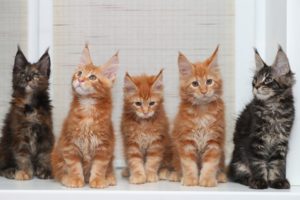The kitten’s health is very fragile, so it is extremely important to carefully monitor it. To be sure that the pet is not sick, make it a rule to conduct an external examination at least 2 times a month. It is most convenient to combine such examinations with routine hygiene procedures: cutting claws, combing, treatment from ectoparasites (for example, fleas and ticks), etc. How to properly conduct such an inspection and what to pay attention to?

SYSTEMATIC
Stick to a certain system that you once chose: so the inspection will be more effective, and the usual procedure will not cause excessive stress in the pet. It is not necessary to randomly sort through different parts of the body in search of pathologies: start, for example, with an examination of the head and move on to other parts of the body, gradually moving towards the tail.
However, even before examining the kitten, you should pay attention to its behavior. A healthy kitten is active and inquisitive, plays a lot and eats well. Apathy and lack of appetite in the baby is a reason to think about his health, and maybe even turn to a veterinarian.
HEAD
First of all, look at the face of the pet. The eyes and nose should be clean, without secretions, redness or dried crusts. Alternately, lift the upper lip from the left and right sides and pay attention to the condition of the gums: they should be pink, moderately moistened and without erosion. Saliva should not leak from the mouth, and the kitten’s teeth should be white and without plaque.
Then look into the kitten’s ears. His auditory passages should be clean, without brown discharge, redness, swelling and traces of scratching. If a kitten often scratches its ears, this may indicate itching, which often occurs with allergies or ectoparasitic diseases (fleas, ear mites).
WOOL AND LEATHER
Wool should evenly cover the body — bald spots are unacceptable. Molting, even the most intense, is always accompanied by the renewal of wool: instead of the old wool, a new one grows without the formation of alopecia (alopecia) zones. Remember that the first molting of kittens occurs at the age of 5 months, and excessive hair loss at an earlier age can indicate health problems.
The skin should be smooth and elastic. Pushing the wool in different directions, forming a “parting”, assess the condition of the skin for inflammation over the entire surface of the body. Pay attention to the presence of dandruff and ectoparasites (for example, fleas).
BELLY
Gently feel the pet’s stomach: normally it should be soft, and probing should not cause significant discomfort to the kitten.
UNDER THE TAIL
Look under the kitten’s tail. The area around the anus and external genitalia should be clean, dry and without signs of inflammation, such as redness, itching or swelling. Urination and defecation should not cause soreness or discomfort in the kitten. If you find that the kitten has started to visit the toilet unusually often or visits to the tray have a longer duration than usual, there is a reason to think about the pet’s health.
IF YOU FIND DEVIATIONS FROM THE NORM
What should I do if you found deviations from the norm during the examination of your pet? In this case, vigilance is not excessive: if signs of ill health are detected, it is always better to contact the clinic to conduct a full examination and receive qualified recommendations for solving possible problems. If you have the necessary basic level of first aid, you need to immediately provide it to the kitten, but if you do not own such a minimal base, then you should not self-medicate, because incorrectly provided assistance can significantly complicate diagnosis and even aggravate pathology.
